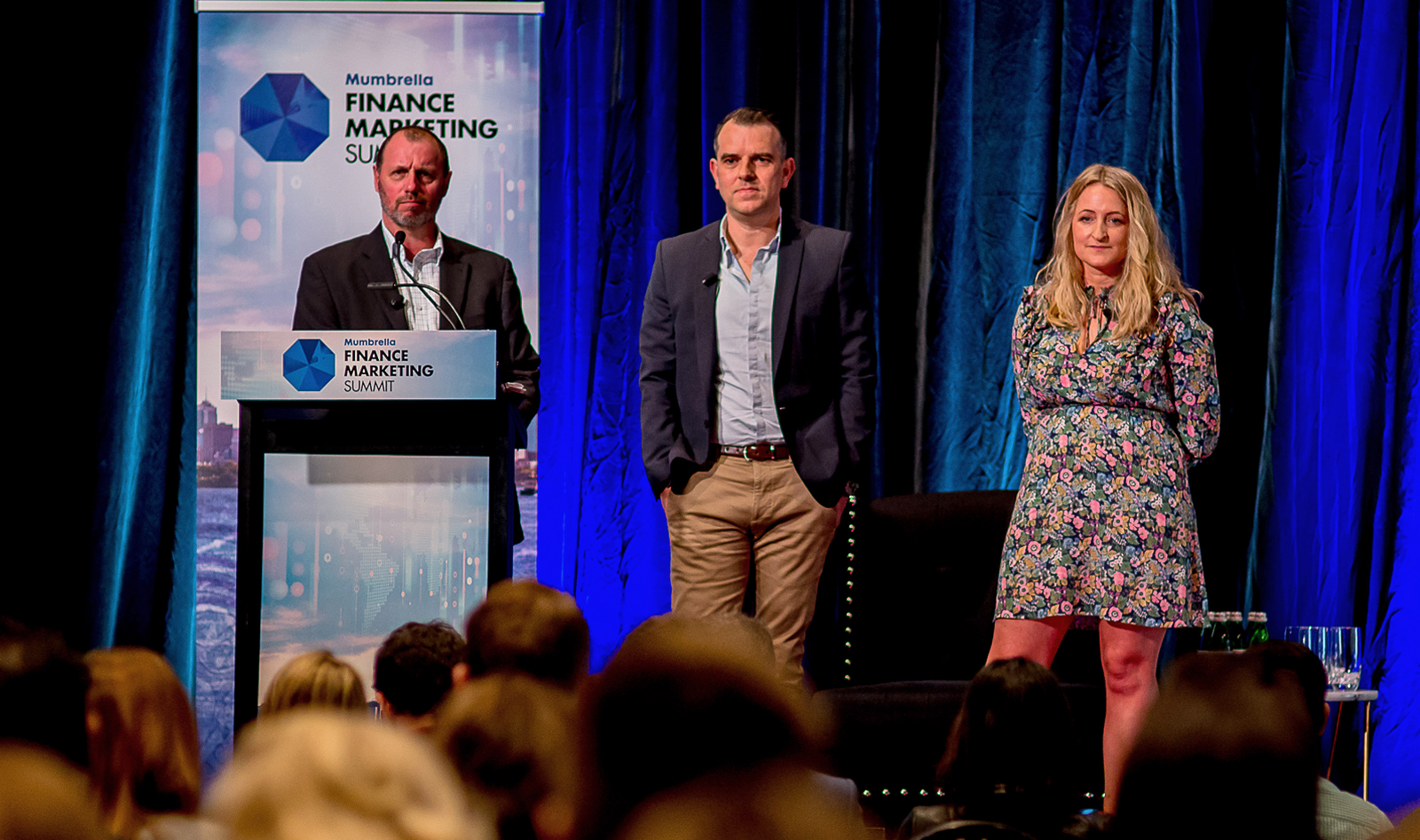As we may have mentioned once or twice before…Yell was asked to open the Mumbrella Finance Marketing Summit this year.
Our presentation on the results of 2017’s Finance Marketing Survey set the scene for the day. By focussing on the issues and opportunities facing finance marketers, as well as exploring the themes of consumer empowerment and trust, it seemed that we hit a rich seam of topics that aligned with many of the other speakers on the day.

We heard from speakers from across the industry, on a multitude of topics at what was a excellent event. In the spirit of sharing, I’ve distilled down the key points as we saw them, which really did reinforce the insights from this year’s survey.
The key trends for 2017/18 are:
- If you get your 121 interaction right, the people will forgive your sins…
- The age of ‘Always There’ is here
- It’s time to think of your audience as a persona of one
- Your chatbot’s personality is the secret to its success
Get your interactions right and the people will forgive you…
It’s been a tough time for the industry with its reputation taking a deserved battering over mis-selling and KYC, with the banks especially in the firing line, amid calls for a Royal Commission. You’d think that would impact on the levels of trust consumers had in that sector, but surprisingly not.
In one of the big surprises of this year’s survey, banks were second only to Super providers in being trusted by consumers. While overall the industry was badly perceived (it came last when compared to pharma, the government, telcos and tech companies), this relatively good result, came against the apparent perceptions presented by the media.
Apparently though, most Australians don’t take much notice of the media noise around the issues in the industry as Anna Bligh, former Premier of Queensland and now Chief Exec of the Australian Bankers Association was quick to confirm. In her opening keynote she echoed our response to a question asked in the Q+A portion of our presentation.
When asked why customers felt that banks were judged by consumers to be relatively trustworthy compared to other financial institutions, despite the storm currently surrounding them, the answer seemed simple. Think of your-day to-day interaction with banks. How often do you go to a branch and queue anymore? In fact, how often do you go to a branch at all? Forgotten your card? No problem, just use your phone to withdraw cash or pay with your phone itself.
Banks are at the leading edge in delivering exceptional digital interactions and through them they’ve made all our lives much easier. As a result, we actually feel pretty good about them, despite the bad press. What does this prove? That direct, specific interactions that make your customers’ lives easier is the quickest way to win their hearts.
The age of ‘Always There’ is here
It won’t be news to any readers of this blog that marketers are more stretched now than ever before. The sheer breadth of topics presented at the Finance Marketing Summit showed that a marketer’s remit spans everything from psychology to social media, click attribution to compliance.
With the rise of content marketing and automation came the term ‘always on’ marketing – content and digital campaigns that, once created, could work around the clock to answer prospects’ queries, build a relationship and nurture them towards a conversion.
It seems that we are now entering the age of ‘always there’ marketing. Consumers expect to be able to actively interact with brands at any time, through any channel, using any device and have a consistently excellent experience.
This undoubtedly presents some very real challenges to finance marketers, but smart firms are already rising to it. A highlight at the Finance Marketing Summit was the presentation of UBank’s home loan chatbot, which provides personalised service to prospects and customers any time, through any device.
Of course, all new technologies take time and resources to plan and implement, but the smart use of tech looks to be how marketers can relieve some of the pressure of ‘always there’ marketing while delivering a better, more personalised service to customers.
Another ‘always there’ angle was presented by Brett Smart of IAG, who encouraged marketers to ‘think outside the media plan’ to deliver ideas that keep working long after they have been paid for. Smart cited the example of the SSGA campaign which aimed to highlight the need for more female leadership in Fortune 500 companies. The resultant ‘Fearless Girl’ statue facing down the Wall St bull became instantly iconic. It generated a huge amount of attention for SSgA and achieved its objective of starting the debate on female leadership.

The statue was originally supposed to be in place for a week but New Yorkers are now petitioning to have it remain permanently, taking ‘always there’ marketing to the next level!
It’s time to think of your audience as a persona of one
One of the liveliest and most interesting sessions was the panel discussion entitled What Age, What Platform? How Does Age Change The Way Marketers Connect? The apparent aim of the session was to establish which platforms work best for different age defined personas.
What evolved was a conversation that essentially blew the notion of Gen Y, Baby Boomers and Gen X out of the water. The days of putting individuals into broad classifications solely based on their age are a thing of the past – or they should be.
The sense we got from the panel was that to use broad marketing personas is now an ineffective, blunt tool. Instead, we should look at reaching individuals, driven by our increasing ability to personalise marketing messaging based on individual behaviour and needs.
Yell believes, and it was born out of this and other sessions on the day, that we’re heading towards a time when we’ll be considering personas of one. That is, building the ability to cater for connecting with an individual and how they interact with brands, where they do it and what they engage with. As automation and the use of marketing AI increases, we see this being a key outcome.
Your chatbot’s personality is the secret to its success
AI and chatbots were definitely the flavor of the month and continue to be a compelling conversation amongst firms of all sizes. We’re working with a number of clients to scope out their requirements and to deliver engaging, on-brand chatbot deployments with both established and emerging firms.
With all martech applications the technology itself is just a tool, and it’s exactly the same with chatbots and AI. Which is why one of the most compelling presentations of the day was from Jo Kelly, UBank’s CMO. Her session talked about how UBank deployed a chatbot in around 6 weeks (!) and was an excellent breakdown of the actual work and expertise required to deploy a working, live AI interaction.
As well as being an interesting window into the process, it also highlighted an increasingly important aspect of the deployment of chatbots – their personality. To think of the bot as an extension of your brand changes how you think about its language, tone, even its name. It’s also important to acknowledge that it’s a bot, not a human, as we’re getting used to that level of interaction and we’re also more forgiving as the technology evolves. We’ll be covering this more in future blogs…
These were just some of the trends from what was an incredibly interesting day, packed full of insights. If you’d like to find out more about the trends, opportunities and challenges that are facing Australian Finance Marketers in 2017 then we’d encourage you to check out the results of the 2017 Finance Marketing Survey.









